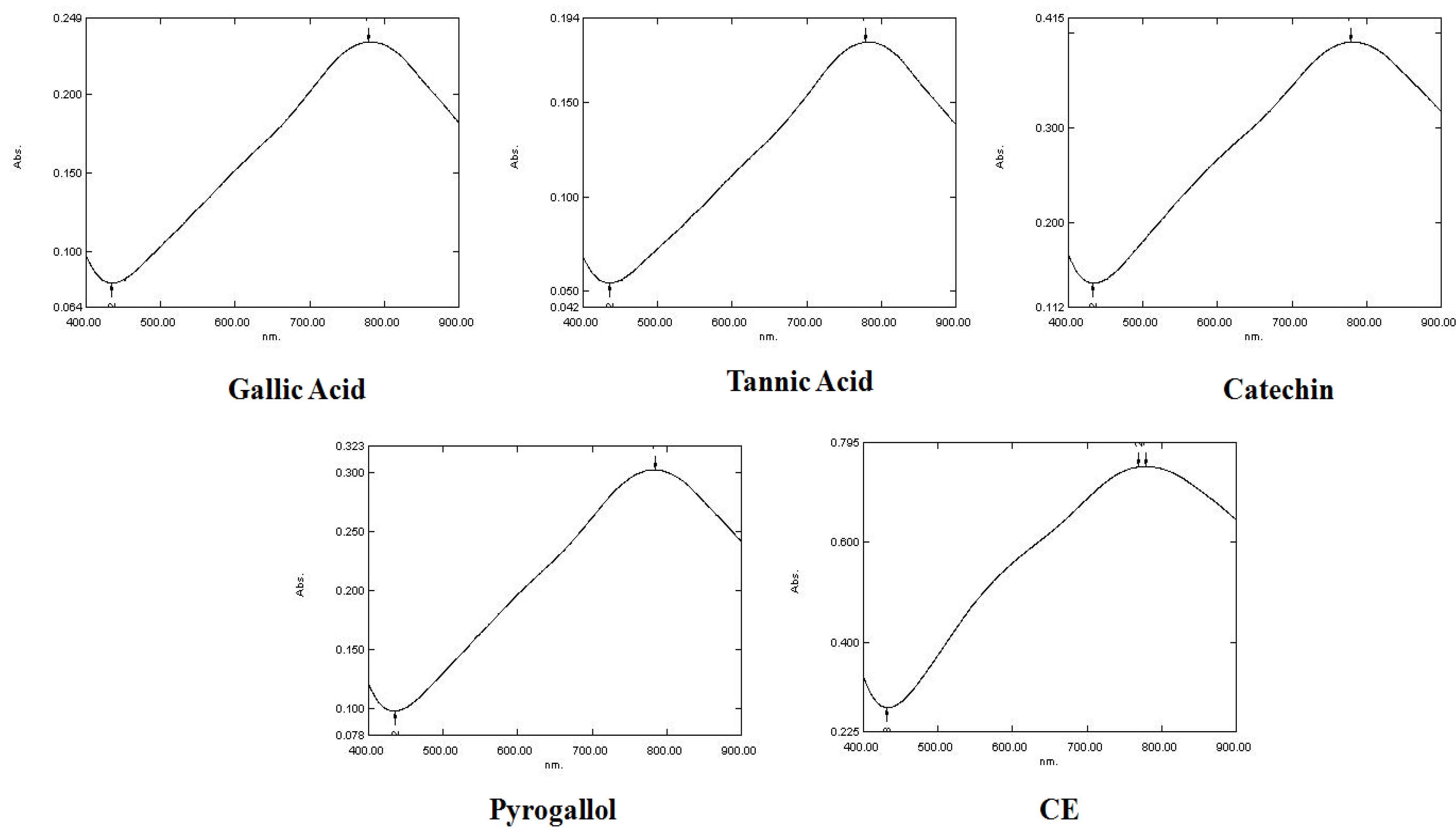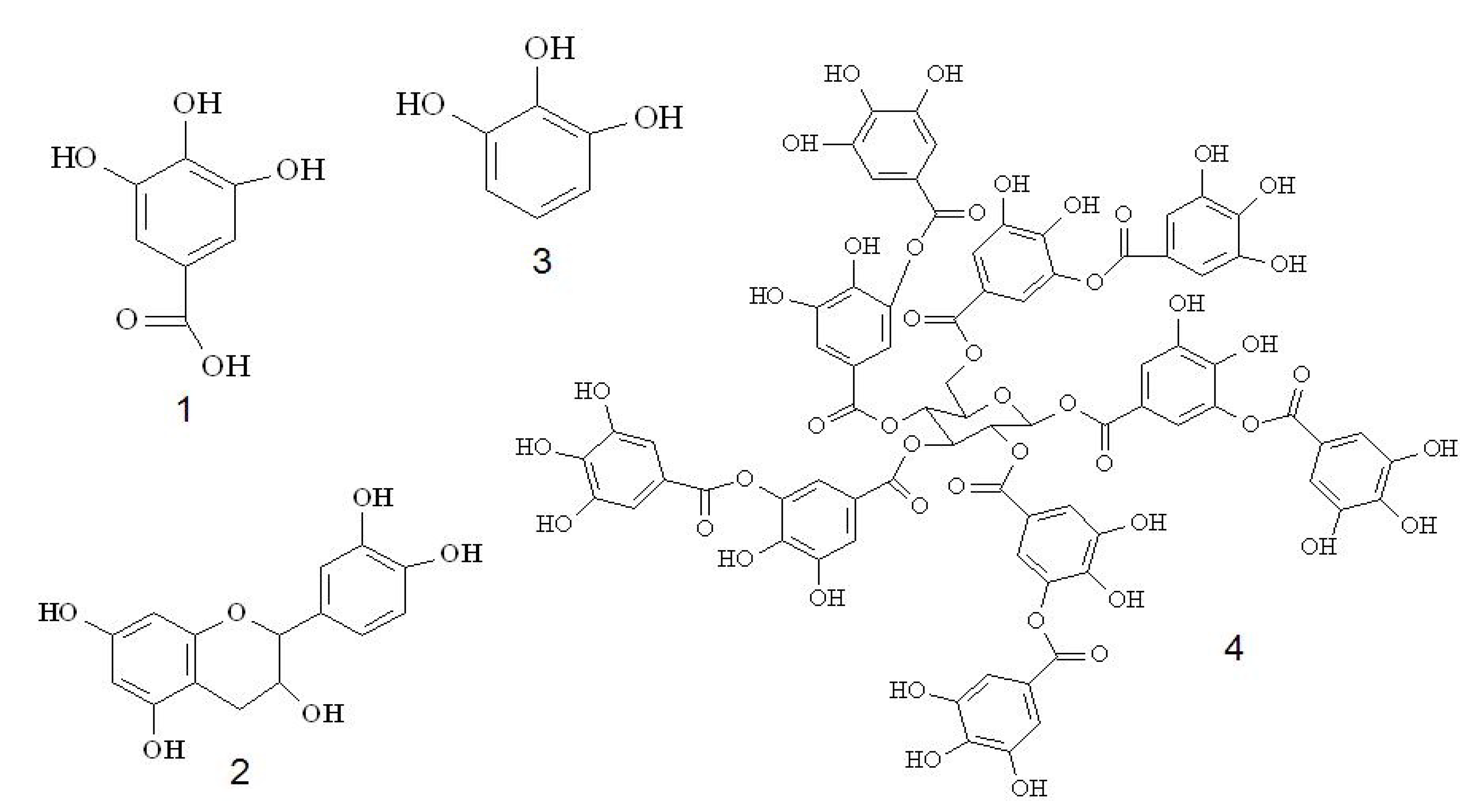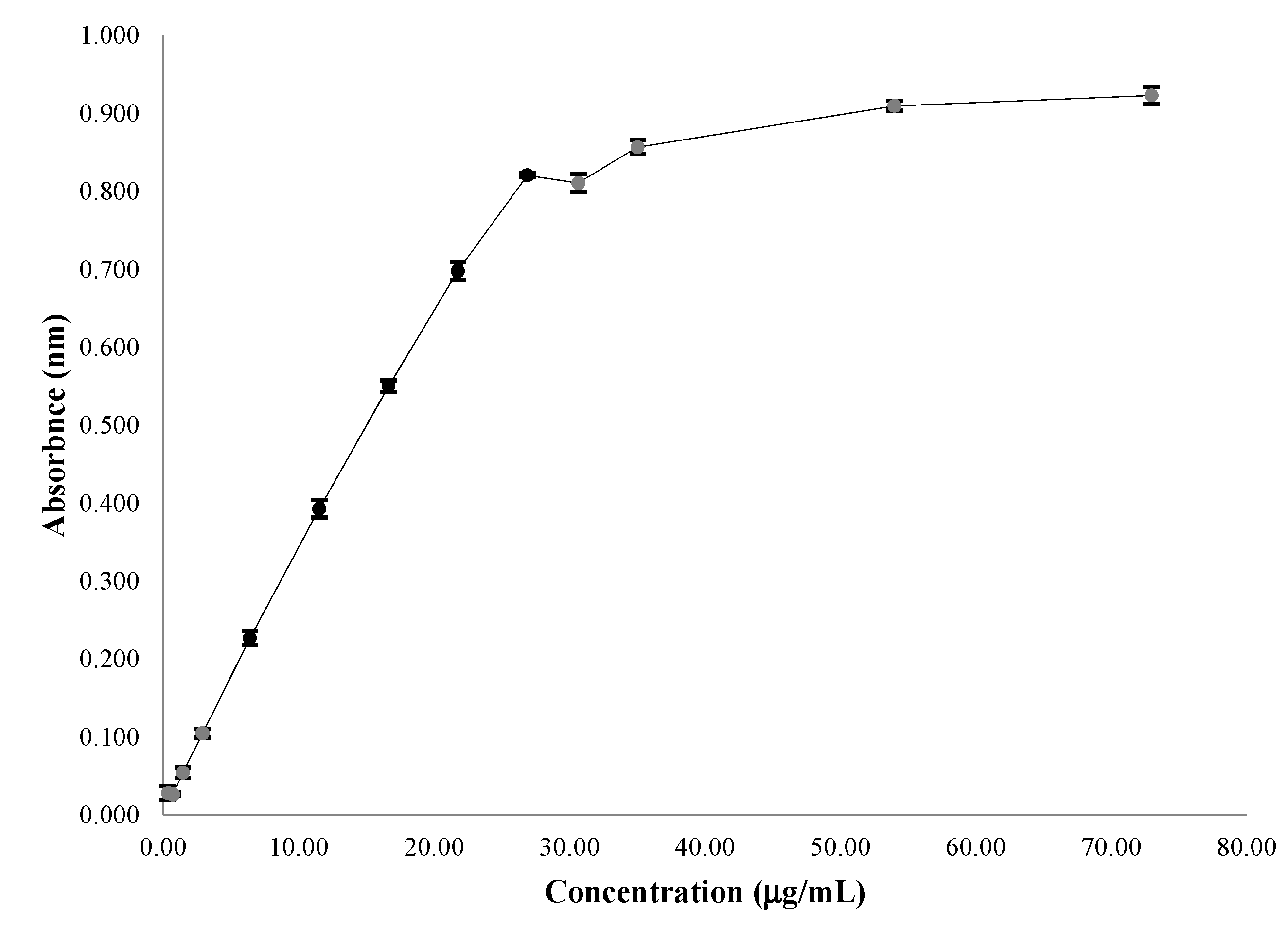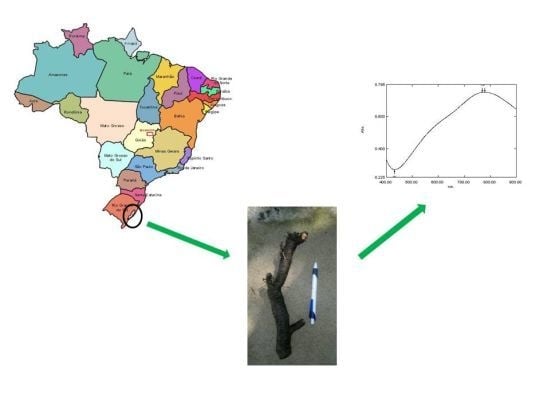Application and Analysis of the Folin Ciocalteu Method for the Determination of the Total Phenolic Content from Limonium Brasiliense L.
Abstract
:1. Introduction
2. Results and Discussion
2.1. Method Optimization


2.2. TP of CE from L. brasiliense and Calibration Curve of Pyrogallol Standard
2.3. Linearity

| Regression analysis | Calibration curve for pyrogallol | Linearity test for CE | Specificity test for CE |
|---|---|---|---|
| Slope (SE) | 0.1407 (0.00225) | 0.029 (0.00040) | 0.031 (0.00030) |
| Intercept (SE) | 0.0044 (0.0078) | 0.046 (0.00010) | 0.133 (0.0008) |
| Regression coefficient (R2) | 0.996 | 0.996 | 0.997 |
| Calculated F-value (critical F-value) | 3.30 (3.71) | 0.26 (3.71) | 1.12 (3.71) |
| Sum of pure error | 0.0990 | 0.0012 | 0.0009 |
| Lack of fit error | 0.0097 | 0.0010 | 0.0008 |
| Analysis of variance | F1,13 = 3901.2, P < 0.001 | F1,13 = 3999.8, P < 0.001 | F1,13 = 5880.8, P < 0.001 |
| CL slope | 0.1359; 0.1456 | 0.0286; 0.0307 | 0.0303; 0.0320 |
| CL intercept | −0.0125; 0.0213 | 0.0284; 0.0652 | 0.1173; 0.1491 |
2.4. Specificity

2.5. Limits of Detection and Quantification
2.6. Precision
2.7. Accuracy
2.8. Robustness
3. Experimental
3.1. Standards and Chemicals
3.2. Plant Material
3.3. Extraction
3.4. Method Optimization and Standardization for Determination of Total Polyphenols (TP)
3.5. Analytical Method Validation
3.6. Method for TP Analysis of CE from L. brasiliense and Calibration Curve of Pyrogallol Standard
3.7. Linearity
3.8. Specificity
3.9. Limits of Detection and Quantification
3.10. Precision
3.11. Accuracy

3.12. Robustness
3.13. Statistical Analysis
4. Conclusions
Acknowledgments
Conflicts of Interest
References
- Gottlieb, O.R.; Borin, M.R. Medicinal products: Regulation of biosynthesis in space and time. Mem. Inst. Oswaldo. Cruz. 2000, 95, 115–120. [Google Scholar] [CrossRef]
- Ferreira, D.; Marais, J.P.J.; Slade, D. Heterogeneity of the interflavanyl bond in proanthocyanidins from natural sources lacking C-4 (C-ring) deoxy flavonoid nucleophiles. Phytochemistry 2005, 66, 2216–2237. [Google Scholar] [CrossRef]
- Okuda, T.; Ito, H. Tannins of constant structure in medicinal and food plants—hydrolyzable tannins and polyphenols related to tannins. Molecules 2011, 16, 2191–2217. [Google Scholar] [CrossRef]
- Lopes, G.C.; Bruschi, M.L.; Mello, J.C.P. RP-LC-UV Determination of proanthocyanidins in Guazuma ulmifolia. Chromatographia 2009, 69, S175–S181. [Google Scholar]
- Møller, C.; Hansen, S.H.; Cornett, C. Characterisation of tannin-containing herbal drugs by HPLC. Phytochem. Anal. 2009, 20, 231–239. [Google Scholar] [CrossRef]
- Lopes, G.C.; Blainski, A.; Santos, P.V.P.; Diciaula, M.C.; Mello, J.C.P. Development and validation of an HPLC method for the determination of epicatechin in Maytenus ilicifolia (Schrad.) Planch. Celastraceae. Rev. Bras. Farmacogn. 2010, 20, 781–788. [Google Scholar]
- Pieroni, L.G.; Rezende, F.M.; Ximenes, V.F.; Dokkedal, A.L. Antioxidant activity and total phenols from the methanolic extract of Miconia. albicans (Sw.) Triana leaves. Molecules 2011, 16, 9439–9450. [Google Scholar]
- Ossipova, S.; Ossipov, V.; Haukioja, E.; Loponen, J.; Pihlaja, K. Proanthocyanidins of mountain birch leaves: Quantification and properties. Phytochem. Anal. 2001, 12, 128–133. [Google Scholar] [CrossRef]
- Verza, S.G.; Kreinecker, M.T.; Reis, V.; Henriques, A.T.; Ortega, G.G. Avaliação das variáveis analíticas do método de Folin-Ciocalteu para determinação do teor de taninos totais utilizando como modelo o extrato aquoso de folhas de Psidium guajava L. (in portuguese). Quím. Nova 2007, 30, 815–820. [Google Scholar]
- Pelozo, M.I.G.; Cardoso, M.L.C.; Mello, J.C.P. Spectrophotometric determination of tannins and caffeine in preparations from Paullinia. cupana var. sorbilis. Braz. Arch. Biol. Technol. 2008, 51, 447–451. [Google Scholar] [CrossRef]
- Schofield, P.; Mbugua, D.M.; Pell, A.N. Analysis of condensed tannins: A review. Anim. Feed Sci. Tech. 2001, 91, 21–40. [Google Scholar] [CrossRef]
- Council of Europe. Determination of tannins in herbal drugs. In European Pharmacopoeia, 6th ed.; European Directorate for the Quality of Medicines: Strasbourg, France, 2007; p. A286. [Google Scholar]
- Farmacopeia Brasileira, 5th ed.; Agência Nacional de Vigilância Sanitária: Brasília, Brazil, 2010.
- Gülçin, I.; Sat, I.G.; Beydemir, S.; Elmastas, M.; Küfrevioğlu, Ö.I. Comparison of antioxidant activity of clove (Eugenia caryophylata Thunb) buds and lavender (Lavandula stoechas L.). Food Chem. 2004, 87, 393–400. [Google Scholar] [CrossRef]
- Folin, O.; Ciocalteu, V. On tyrosine and tryptophane determinations in proteins. J. Biol. Chem. 1927, 73, 627–650. [Google Scholar]
- Glasl, H. Zur Photometrie in der Drogenstandardisierung. 3. Gehaltsbestimmung von Gerbstoffdrogen. Dtsch Apoth Ztg 1983, 123, 1979–1983. [Google Scholar]
- Cicco, N.; Lanorte, M.T.; Paraggio, M.; Viggiano, M.; Lattanzio, V. A reproducible, rapid and inexpensive Folin-Ciocalteu micro-method in determining phenolics of plant methanol extracts. Microchem. J. 2009, 91, 107–110. [Google Scholar] [CrossRef]
- Bueno, F.G.; Machareth, M.A.D.; Panizzon, G.P.; Lopes, G.C.; Leite-Mello, E.V.S.; Mello, J.C.P. Development of a UV/VIS spectrophotometric method for analysis of total polyphenols from Caesalpinia. peltophoroides Benth. Quím. Nova 2012, 35, 822–826. [Google Scholar]
- Dias da Silva, R.A. Plantas medicinaes do Brasil, o guaycuru (in portuguese). Bol. Assoc. Bras. Pharm 1920, 1, 4–14. [Google Scholar]
- Moura, T.F.A.L. Sobre o Limonium brasiliense (Boiss.) Kuntze, Plumbaginaceae, o baicuru. M.S. Thesis, Federal University of Rio Grande do Sul, Porto Alegre, Brazil, 1984. [Google Scholar]
- Murray, A.P.; Rodriguez, S.; Frontera, M.A.; Tomas, M.A.; Mulet, A.C. Antioxidant metabolites from Limonium brasiliense (Boiss.) Kuntze. Z Naturforsch C 2004, 59, 477–480. [Google Scholar]
- Cardoso, M.L.C. Limonium brasiliense (Boiss.) Kuntze, Plumbaginaceae (Baicuru): Desenvolvimento galênico de extratos. M.S. Thesis, Federal University of Rio Grande do Sul, Porto Alegre, Brazil, 1990. [Google Scholar]
- Fenner, R.; Betti, A.H.; Mentz, L.A.; Rates, S.M.K. Plantas utilizadas na medicina popular brasileira com potencial atividade antifúngica. (in portuguese). Rev. Bras. Ciênc Farm. 2006, 42, 269–394. [Google Scholar]
- Janhs, R.T.; Crescente, A.S. Ensaios farmacológicos e clínicos com a associação do extrato fluido de Limonium brasiliense e N-acetil-p-aminophenol. Trib. Pharm. 1976, 44, 105–111. [Google Scholar]
- Singleton, V.L.; Orthofer, R.; Lamuela-Raventos, R.M. Analysis of total phenols and other oxidation substrates and antioxidants by means of Folin-Ciocalteu reagent. Method Enzymol. 1999, 299, 152–178. [Google Scholar] [CrossRef]
- Bruce, P.; Minkkinen, P.; Riekkola, M.-L. Practical method validation: Validation sufficient for an analysis method. Microchim. Acta 1998, 128, 93–106. [Google Scholar] [CrossRef]
- Ribani, M.; Bottoli, C.B.G.; Collins, C.H.; Jardim, I.C.S.F.; Melo, L.F.C. Validação em métodos cromatográficos e eletroforéticos. Quím. Nova 2004, 27, 771–780. [Google Scholar]
- International Conference on Harmonization. International Conference on Harmonization of Technical Requirements for Registration of Pharmaceuticals for Human Use. In In Q2B(R1): Guideline on Validation of Analytical Procedure- Methodology; ICH Steering Committee: Brussels, Belgium, 2005. [Google Scholar]
- Vogel, A.I. Química Analítica Quantitativa, 6th ed.; Afonso, J.C., Aguiar, P.F., Alemcastro, R.B., Eds.; LTC: Rio de Janeiro, Brazil, 2002; p. 462. [Google Scholar]
- Agência Nacional de Vigilância Sanitária. RE No. 899, 29/5/2003: Guia para Validação de Métodos Analíticos e Bioanalíticos; (in portuguese). Ministério da Saúde: Brasília, Brazil, 2003. [Google Scholar]
- Sample Availability: Samples of the extracts are available from the authors.
© 2013 by the authors; licensee MDPI, Basel, Switzerland. This article is an open access article distributed under the terms and conditions of the Creative Commons Attribution license (http://creativecommons.org/licenses/by/3.0/).
Share and Cite
Blainski, A.; Lopes, G.C.; De Mello, J.C.P. Application and Analysis of the Folin Ciocalteu Method for the Determination of the Total Phenolic Content from Limonium Brasiliense L. Molecules 2013, 18, 6852-6865. https://doi.org/10.3390/molecules18066852
Blainski A, Lopes GC, De Mello JCP. Application and Analysis of the Folin Ciocalteu Method for the Determination of the Total Phenolic Content from Limonium Brasiliense L. Molecules. 2013; 18(6):6852-6865. https://doi.org/10.3390/molecules18066852
Chicago/Turabian StyleBlainski, Andressa, Gisely Cristiny Lopes, and João Carlos Palazzo De Mello. 2013. "Application and Analysis of the Folin Ciocalteu Method for the Determination of the Total Phenolic Content from Limonium Brasiliense L." Molecules 18, no. 6: 6852-6865. https://doi.org/10.3390/molecules18066852
APA StyleBlainski, A., Lopes, G. C., & De Mello, J. C. P. (2013). Application and Analysis of the Folin Ciocalteu Method for the Determination of the Total Phenolic Content from Limonium Brasiliense L. Molecules, 18(6), 6852-6865. https://doi.org/10.3390/molecules18066852





